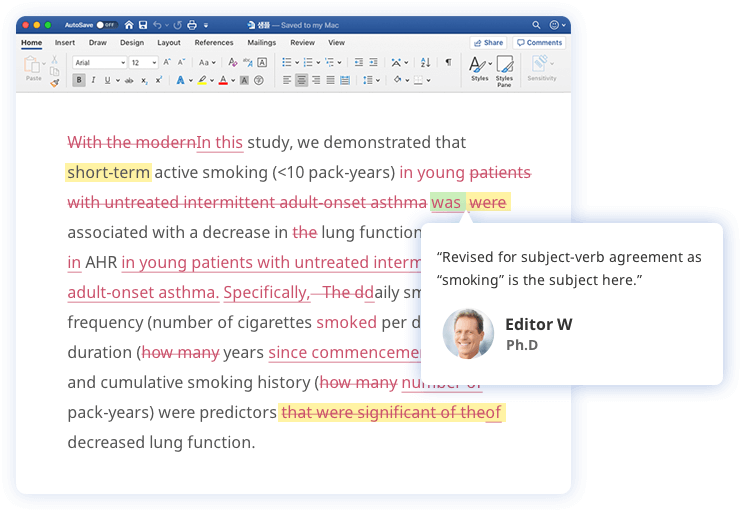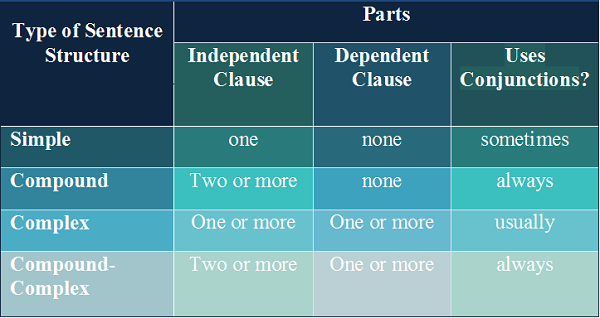A sentence is a group of words that expresses a complete thought and contains a subject and a predicate. The most basic sentence structure consists of only one clause. However, many sentences have one main clause and one or more subordinate clauses.
The standard order of words in an English sentence is subject + verb + object. While this sounds simple, it may be difficult to identify the subject(s), verb(s), and object(s), depending on the structure and complexity of the sentence. There are four types of sentence structure: (1) simple, (2) compound, (3) complex, and (4) compound-complex.
Types of sentence structures
| Sentence structure type | Sentence parts | Example |
|---|---|---|
| Simple Sentence |
Independent clause |
I like animals. |
| Compound Sentence |
Independent clause + coordinating |
I like animals, |
| Complex Sentence |
Independent clause + |
I like animals |
|
Compound-Complex Sentence |
Independent clause + |
I like animals |
Sentence Structures in Academic Writing
Simple Sentence Structure
A simple sentence is the most basic sentence structure and consists of a single independent clause.
Types of clauses
An independent clause expresses a full thought. Only independent clauses can function as complete sentences.
- Example
- The proposed system has the advantage of a wide scope.
I went shopping last weekend.
The cat is sleeping by the window.
In contrast, a dependent clause does not express a full thought and cannot function as a complete sentence.
- Example
- which was developed over three months
even though I was tired
because the weather is sunny
A dependent clause starts with either a relative pronoun or subordinating conjunction.
Common subordinating conjunctions
because, since, once, although, if, until, unless, why, while, whether, than, that, in order to
Common relative pronouns
that, which, who, whom, whoever, whomever
Subject of a sentence
The subject is whatever is performing the action of the sentence. This is the first of the two basic components of a sentence.
- Example
- This study investigated the relationship between the personal traits and clinical parameters.
- Example
- Dolly made a cake for the party.
Predicate of a sentence
The predicate contains the verb (the action) and can include further clarifying information.
- Example
- This study investigated the relationship between the personal traits and clinical parameters.
- Example
- Mary gave her sheep a bath.
Direct and Indirect Objects
The direct object is the person, thing, or idea that receives an action.
- Example
- This study investigated the relationship between the personal traits and clinical parameters.
- Example
- Dolly made a cake.
The indirect object is the person, thing, or idea for which an action is being done.
- Example
- The national lab offered us an opportunity to work on an exciting new project.
- Example
- Mary gave her sheep a bath.
Transitive vs. Intransitive Verbs
A transitive verb is the action the subject takes on a direct object.
- Example
- We fabricated a composite.
Here, “we” is the subject, “fabricated” is the transitive verb, and “a composite” is the direct object.
An intransitive verb is a verb that does not have to be followed by an object. Intransitive verbs can function as predicates all on their own.
- Example
- We arrived.
We arrived early.
- Example
- I always eat.
I always eat before work.
“We” and “I” are the subjects; “arrived” and “eat” are intransitive verbs.
Subject Complement
A subject complement complements the subject by renaming or describing it. Subject complements always follow a linking verb, which is often a form of the verb “to be.”
- Example
- The material is a gold composite.
“Gold composite” renames the subject “the material.”
- Example
- Charlotte is very pretty.
“Pretty” describes the subject “Charlotte.”
Get professional proofreading and expert feedback on any document!

-
Academic papers
-
Admissions essays
-
CVs/resumes
-
Business reports
-
Blog and website content
-
Personal essays
Compound Sentence Structure
A compound sentence is composed of two or more independent clauses connected by a coordinating conjunction or semicolon. Note that US English conventions dictate that coordinating conjunctions must be used with a comma when joining independent clauses.
Structure of a Compound Sentence: Independent clause + coordinating conjunction (or semicolon) + independent clause
List of coordinating conjunctions: and, but, yet, or, nor, for, so
- Example
- The material is a gold composite, and it was fabricated in clean room no. 45.
- Example
- Glenda usually eats before work, but today she could not.
- Example
- The proposed system has the advantage of a wide scope; it uses a novel algorithm that expands the range by a factor of ten.
Complex Sentence Structure
A complex sentence is composed of an independent clause and a dependent clause.
Structure of a Complex Sentence: Independent clause + subordinating conjunction (or relative pronoun) + dependent clause
- Example
- We built a new system because the previous model had to be narrowed in scope.
- Example
- Sarah will buy a train ticket if her flight is cancelled.
Compound-Complex Sentence Structure
A compound-complex sentence is composed of two or more independent clauses and one or more dependent clauses.
Structure of a Compound-Complex Sentence: Independent clause + subordinating conjunction + dependent clause + coordinating conjunction + independent clause
- Example
- The first method failed because it caused the wires to melt, but the second method succeeded in bending the wires without causing the same issue.
- Example
- Sarah’s flight took off before she started driving to the airport, so she drove to the train station instead.
Normally, sentences in the English language take a simple form. However, there are times it would be a little complex. In these cases, the basic rules for how words appear in a sentence can help you.
Word order typically refers to the way the words in a sentence are arranged. In the English language, the order of words is important if you wish to accurately and effectively communicate your thoughts and ideas.
Although there are some exceptions to these rules, this article aims to outline some basic sentence structures that can be used as templates. Also, the article provides the rules for the ordering of adverbs and adjectives in English sentences.
Basic Sentence Structure and word order rules in English
For English sentences, the simple rule of thumb is that the subject should always come before the verb followed by the object. This rule is usually referred to as the SVO word order, and then most sentences must conform to this. However, it is essential to know that this rule only applies to sentences that have a subject, verb, and object.
For example
Subject + Verb + Object
He loves food
She killed the rat
Sentences are usually made of at least one clause. A clause is a string of words with a subject(noun) and a predicate (verb). A sentence with just one clause is referred to as a simple sentence, while those with more than one clause are referred to as compound sentences, complex sentences, or compound-complex sentences.
The following is an explanation and example of the most commonly used clause patterns in the English language.
 Inversion
Inversion
The English word order is inverted in questions. The subject changes its place in a question. Also, English questions usually begin with a verb or a helping verb if the verb is complex.
For example
Verb + Subject + object
Can you finish the assignment?
Did you go to work?
 Intransitive Verbs
Intransitive Verbs
Some sentences use verbs that require no object or nothing else to follow them. These verbs are generally referred to as intransitive verbs. With intransitive verbs, you can form the most basic sentences since all that is required is a subject (made of one noun) and a predicate (made of one verb).
For example
Subject + verb
John eats
Christine fights
 Linking Verbs
Linking Verbs
Linking verbs are verbs that connect a subject to the quality of the subject. Sentences that use linking verbs usually contain a subject, the linking verb and a subject complement or predicate adjective in this order.
For example
Subject + verb + Subject complement/Predicate adjective
The dress was beautiful
Her voice was amazing
 Transitive Verbs
Transitive Verbs
Transitive verbs are verbs that tell what the subject did to something else. Sentences that use transitive verbs usually contain a subject, the transitive verb, and a direct object, usually in this order.
For example
Subject + Verb + Direct object
The father slapped his son
The teacher questioned his students
 Indirect Objects
Indirect Objects
Sentences with transitive verbs can have a mixture of direct and indirect objects. Indirect objects are usually the receiver of the action or the audience of the direct object.
For example
Subject + Verb + IndirectObject + DirectObject
He gave the man a good job.
The singer gave the crowd a spectacular concert.
The order of direct and indirect objects can also be reversed. However, for the reversal of the order, there needs to be the inclusion of the preposition “to” before the indirect object. The addition of the preposition transforms the indirect object into what is called a prepositional phrase.
For example
Subject + Verb + DirectObject + Preposition + IndirectObject
He gave a lot of money to the man
The singer gave a spectacular concert to the crowd.
 Adverbials
Adverbials
Adverbs are phrases or words that modify or qualify a verb, adjective, or other adverbs. They typically provide information on the when, where, how, and why of an action. Adverbs are usually very difficult to place as they can be in different positions in a sentence. Changing the placement of an adverb in a sentence can change the meaning or emphasis of that sentence.
Therefore, adverbials should be placed as close as possible to the things they modify, generally before the verbs.
For example
He hastily went to work.
He hurriedly ate his food.
However, if the verb is transitive, then the adverb should come after the transitive verb.
For example
John sat uncomfortably in the examination exam.
She spoke quietly in the class
The adverb of place is usually placed before the adverb of time
For example
John goes to work every morning
They arrived at school very late
The adverb of time can also be placed at the beginning of a sentence
For example
On Sunday he is traveling home
Every evening James jogs around the block
When there is more than one verb in the sentence, the adverb should be placed after the first verb.
For example
Peter will never forget his first dog
She has always loved eating rice.
 Adjectives
Adjectives
Adjectives commonly refer to words that are used to describe someone or something. Adjectives can appear almost anywhere in the sentence.
Adjectives can sometimes appear after the verb to be
For example
He is fat
She is big
Adjectives can also appear before a noun.
For example
A big house
A fat boy
However, some sentences can contain more than one adjective to describe something or someone. These adjectives have an order in which they can appear before a now. The order is
Opinion – size – physical quality – shape – condition – age – color – pattern – origin – material – type – purpose
If more than one adjective is expected to come before a noun in a sentence, then it should follow this order. This order feels intuitive for native English speakers. However, it can be a little difficult to unpack for non-native English speakers.
For example
The ugly old woman is back
The dirty red car parked outside your house
When more than one adjective comes after a verb, it is usually connected by and
For example
The room is dark and cold
Having said that, Susan is tall and big
Get an expert to perfect your paper
1. What is Sentence Structure?
A sentence’s “structure” is the way its words are arranged.
In English, we have four main sentence structures: the simple sentence, the compound sentence, the complex sentence, and the compound-complex sentence. Each uses a specific combination of independent and dependent clauses to help make sure that our sentences are strong, informational, and most importantly, that they make sense!
2. Examples of Sentence Structures
In the examples, independent clauses are green, dependent clauses are purple, and conjunctions are orange. Here are examples of each type of sentence:
- The dog ran. Simple Sentence
- The dog ran and he ate popcorn. Compound sentence
- After the dog ran, he ate popcorn. Complex sentence
- After the dog ran, he ate popcorn and he drank a big soda. Compound-complex sentence
3. Parts of Sentence Structures
All forms of sentence structures have clauses (independent, dependent, or both), and some also have conjunctions to help join two or more clauses or whole sentences.
a. Independent Clause
Independent clauses are key parts of every sentence structure. An independent clause has a subject and a predicate and makes sense on its own as a complete sentence. Here are a few:
- The dog ate brownies.
- The dog jumped high.
- She ate waffles.
- He went to the library.
So, you can see that all of the clauses above are working sentences. What’s more, all sentences have an independent clause!
b. Dependent (Subordinate) Clause
A dependent clause is a major part of three of the four sentence structures (compound, complex, and compound-complex). It has a subject and a predicate; BUT, it can’t be a sentence. It provides extra details about the independent clause, and it doesn’t make sense on its own, like these:
- After he went to the party
- Though he ate hotdogs
- While he was at the dance
- If the dog eats chocolate
Each of the bullets above leaves an unanswered question. By itself, a dependent clause is just a fragment sentence (an incomplete sentence). So, it needs to be combined with an independent clause to be a sentence.
c. Conjunction
A conjunction is a word in a sentence that connects other words, phrases and clauses. Conjunctions are a big part of compound, complex, and compound-complex sentences. The most common conjunction that you know is “and.” Others are for, but, or, yet, and so. Conjunctions are important because they let us combine information, but still keep ideas separate so that they are easy to understand.
Here are two sentences, with and without conjunctions:
Incorrect: The girl ran to the ice cream truck then she ate ice cream.
Correct: The girl ran to the ice cream truck, and then she ate ice cream.
So, you can see that we need a conjunction for the sentence to be clear!
It is important to know that the word “then” is NOT a conjunction—it’s an adverb.
4. Types of Sentence Structures
As mentioned, there are four main types of sentence structures: simple, compound, complex, and compound-complex. To begin, here is a simple chart that outlines the patterns of each type.
a. Simple sentence
A simple sentence has only one subject and one predicate—one independent clause. In fact, an independent clause itself is a simple sentence. Here are some examples:
- She jumped.
- The cheetah ran.
- He ran to the gas station.
- He ate dinner.
Simple sentences don’t have many details and they don’t really combine multiple ideas—they are simple!
b. Compound sentence
A compound sentence has at least two independent clauses. It uses a conjunction like “and” to connect the ideas. Here are some examples:
- The dog ate pizza but the cat drank apple juice.
- The dog ate pizza but the cat drank apple juice and the fish had eggs.
As you can see, a compound sentence allows us to share a lot of information by combining two or more complete thoughts into one sentence.
c. Complex sentence
A complex sentence has one independent clause and one or more dependent clauses. It sometimes uses conjunctions and other words to combine all of the clauses together.
- When he was on the airplane, the man bought cookies.
- When he was on the airplane, the man bought cookies, but not brownies.
A great way to make a sentence more detailed is by adding dependent clauses (which couldn’t be sentences on their own). So, complex sentences let us add information to simple sentences.
d. Compound-complex sentence
A compound-complex sentence has two or more independent clauses and at least one dependent clause—so, it uses conjunction(s) to combine two complete sentences and at least one incomplete sentence. Here is an example:
The girl smelled cookies, which were baking at home, so, she ran all the way there.
The result of combining the three clauses and the conjunction is a compound-complex sentence that is both informational and easy to understand. The independent clauses give the main information, and the dependent clause(s) give the details.
5. How to Avoid Mistakes
When it comes to making sure your sentence is clear and complete, having the right sentence structure is very important. A couple of common mistakes can happen when you forget how to use clauses or conjunctions in the right way, like run-on sentences and fragment sentences.
a. Run-on sentences
In simple terms, a run-on sentence is a sentence that is too long. For instance, if a writer forgets to use conjunctions, a sentence seems like it “runs on” for too long. For example:
The fox really liked pancakes, he ate them every day for breakfast, he couldn’t eat them without syrup and butter.
But, with the right conjunctions, this can be a normal compound sentence:
The fox really liked pancakes, so, he ate them every day for breakfast; but, he couldn’t eat them without syrup and butter.
As you can see, the new sentence is much easier to read and makes more sense.
b. Fragment (incomplete) sentences
A “fragment” is a small piece of something. So, a fragment sentence is just a piece of a sentence: it is missing a subject, a predicate, or an independent clause. It’s simply an incomplete sentence. Fragment sentences can happen when you forget an independent clause.
For instance, by itself, a dependent clause is just a fragment. Let’s use a couple of the dependent clauses from above:
- While he was at the dance What happened?
- If he eats chocolate Then what?
As you can see, each leaves an unanswered question. So, let’s complete them:
- While he was at the dance, the dog drank fruit punch.
- The dog will get a stomachache if he eats chocolate.
Here, we completed the fragment sentences by adding independent clauses (underlined), which made them into complex sentences.
Test your Knowledge
1.
Which type of sentence combines two independent clauses?
a.Compound sentence
b.Simple sentence
c.None of the above
d.All of the above
2.
Which type of sentence can have two or more independent and dependent clauses?
a.Simple sentence
b.Compound-complex sentence
c.Compound sentence
d.None of the above
3.
Add a conjunction or conjunctions to make the following sentence clearer: The dog and the cat loved to eat ice cream, they liked going fishing, searching for clovers.
a.The dog and the cat loved to eat ice cream, they liked going fishing, and searching for clovers.
b.The dog and the cat loved to eat ice cream, so they liked going fishing, searching for clovers.
c.The dog and the cat loved to eat ice cream, and they liked going fishing, searching for clovers.
d.The dog and the cat loved to eat popcorn, and they liked going fishing and searching for clovers.
4.
Add an independent clause to complete the following sentence: If the rabbit goes to the dentist,
a.and
b.and gets a sticker.
c.he will get his teeth cleaned.
d.and his teeth cleaned.
Word order and sentence structure are essential for any language-learner. They can determine the meaning of a sentence, help you emphasize certain aspects of the sentence, and allow your speech and writing to sound more natural.
In this article, I’ll guide you through the following two topics:
- Correct sentence structure in English
- English word order rules
I’ll also provide you with several English word order examples along the way, so you can see how it all works together.
Once you understand the most basic English sentence structures, you’ll be a much more effective communicator. Before we continue, you may find it helpful to take a look at our English grammar page and familiarize yourself with some of the topics I’ll cover.
Let’s get started!
Table of Contents
- Overview of Word Order in English
- Basic Sentence Structure Rules
- Let’s Add Prepositional Phrases
- And Now Modifiers
- Sentence Transformations!
- Final Thoughts
1. Overview of Word Order in English
What is the order of an English sentence?
Overall, the sentence structures in English are very flexible. Which structure you use depends on context and personal preference, although Subject + Verb + Object (SVO) is the most common structure. For example:
“I pet the cat.“
It’s also possible to form very simple sentences with only the subject and verb as long as they form a complete thought (SV):
“He ran.“
That said, there are four types of sentence structures that are commonly used in English.
1- The Four Types of Sentence Structures
Before we go any further, you need to know the difference between dependent and independent clauses.
1. Dependent vs. Independent
Dependent:
A dependent clause is one that requires an independent clause to be a complete sentence. Dependent clauses do not contain enough information (a subject, verb, and complete idea) to be a sentence. An example would be the clause “Since Kaitlyn didn’t come.”
This clause leaves the listener wanting more information. What was the result of Kaitlyn not coming?
Independent:
An independent clause is one that can be used by itself and contains all the information it needs to be complete. An example would be the clause “I felt lonely.”
Although we don’t have tons of information available to us, the above clause represents a complete idea. It has a subject (I), a verb (felt), and a word that adds necessary information to the verb (lonely).
Putting Them Together:
Remember how I said that a dependent clause needs an independent clause to be complete? Check this out:
“Since Kaitlyn didn’t come, I felt lonely.”
Now we have an answer to what was previously a dependent clause. And now we have even added more information to the already-completed independent clause. It’s a win-win!
2. What are Four Types of Sentence Structures?
There are four basic English sentence structure types (simple, compound, complex, compound-complex). We’ve outlined them below.
| Definition | Examples | |
|---|---|---|
| Simple | Requires a subject and a verb.
Consists of one independent clause. Sometimes it has an object as well. |
“I worked.” OR “I worked on the book.”
He proposed. OR “He proposed to her.” “She smiled.” OR “She smiled at him.” |
| Compound | Consists of two (or more) independent clauses.
The independent clauses are usually connected by a linking word or phrase (as shown in these examples), a semicolon, or a colon. |
“I worked, and then I made dinner.”
“He proposed, and she said yes.” “She smiled and (she) took his hand.” |
| Complex | Consists of one independent clause and one dependent clause. | “I worked, even though I was tired.“
“Though nervous, he proposed.“ “Because she smiled, he was happy.“ |
| Compound-Complex | Consists of two independent clauses and one dependent clause. | “I worked, even though I was tired, and then I made dinner.“
“Though nervous, he proposed, and she said yes.“ “Because she smiled, he was happy; then she took his hand.“ |
This is just an overview. In the following sections, I’ll go into more detail about how these sentence transformations work, starting with the basics of word order in English.
2. Basic Sentence Structure Rules
As mentioned earlier, in English, you only need two words to create a whole sentence: The subject (S) and the verb (V). This is the SV sentence structure.
“Sarah writes.“
You can add more information to this simple sentence by adding an object (O) to the end. This becomes the SVO sentence structure.
“Sarah writes poetry.“
The SV and SVO sentence structures are the most common structures in the United States. The only real exception is when people are giving a command or asking a question. In this case, they may be able to get away with using one word or an incomplete thought:
- “Peter!” (S)
- “Stop!” (V)
- “The book!” (O)
- “Why?” (Question)
In the cases above, the context will help you determine the meaning.
In all other situations, it’s most proper to use the SV or SVO structure (unless you want to talk like Yoda with OSV).
3. Let’s Add Prepositional Phrases
1- The Basics
What happens to a sentence when you add a prepositional phrase? What does that look like?
A prepositional phrase adds information to simple sentences. Often, it answers the questions of where, when, how, and why something happened.
Here are four examples of prepositional phrases:
- In the park (Where)
“Sarah writes poetry in the park.”
- At night (When)
“Sarah writes poetry at night.”
- By herself (How)
“Sarah writes poetry by herself.”
- Because it’s fun (Why)
“Sarah writes poetry because it’s fun.”
2- Position in a Sentence
In the above examples, the prepositional phrases are at the end of the sentence. But, a prepositional phrase can also come at the beginning of a sentence, although this is less common. The order you choose depends on what you want to emphasize in your sentence.
For example, if you want to emphasize what time Sarah writes poetry, you could say:
“At night, Sarah writes poetry.“
This indicates when Sarah chooses to write. It also suggests that when she writes is more important than the fact that she writes poetry in general.
3- What to do with Multiple Prepositions
What if you wanted to tell someone all the information above in one sentence? Well, here are a few different ways:
- “Sarah writes poetry in the park by herself at night because it’s fun.“
- “In the park, Sarah writes poetry at night by herself because it’s fun.“
- “At night, Sarah writes poetry in the park by herself because it’s fun.“
- “Sarah writes poetry by herself in the park at night because it’s fun.“
- “At night, in the park by herself, Sarah writes poetry because it’s fun.“
Note that, usually, the why prepositional phrase comes at the end of the sentence. It tends to sound better there, and people are still able to emphasize it when it’s at the end through tone of voice.
As you can see, the word order in English sentences for prepositional phrases is flexible. In general, you can choose the order that makes the most sense to you.
And don’t worry too much. In most cases, people don’t use sentences this long in conversations! Instead, you’re more likely to hear a simple: “Sarah writes poetry in the park at night.“
4. And Now Modifiers
A modifier is a word that modifies (adds info or meaning to) another word, usually a noun or verb. Below is an English word order chart describing each type of modifier with examples.
| Definition | Examples | Usage | Placement | |
|---|---|---|---|---|
| Adjectives | Words that describe a noun. | Hot
Easy |
1. “It was a hot day.”
2. “The test was easy.” |
1. Before the noun it describes.
2. After the noun it describes, with a “be” verb in between. |
| Adverbs | Words that describe a verb. | Quickly
Carefully Hopefully Currently |
1. “Quickly, I ran.”
2. “She put the knife down carefully.” 3. “The cat followed hopefully after its owner.” 4. “I currently don’t own a cat.” |
1. Beginning of a sentence.
2. End of a sentence. 3. After the verb it describes. 4. After the subject performing the verb. |
| Determiners | Words that indicate which of something you’re talking about. | This
That These Those |
1. “This is good.”
2. “He didn’t know that.” 3. “These cookies are delicious.” 4. “Aren’t those strange?” |
1. Beginning of a sentence.
2. End of a sentence. 3. Before a noun. 4. After a verb and before an adjective. |
| Numerals | Numbers that describe how many. | One
Two Three |
1. “One more, please.”
2. “Can I have two?” 3. “I want three donuts.” |
1. Beginning of a sentence.
2. End of a sentence. 3. After a verb. |
| Possessors | Words that indicate who possesses something. | His
Her |
1. “That book is his.”
2. “Where’s her backpack?” |
1. End of a sentence.
2. Before a noun, usually an object. |
| Relative Clauses | A series of words that add information to a sentence. | That I ordered
That he saw Of the color That she wore |
1. “That I ordered a bicycle is strange.”
2. “Where’s the squirrel that he saw?” 3. “The flower was of the color red.” 4. “The dress that she wore was very pretty.” |
1. Beginning of a sentence. [uncommon]
2. End of a sentence. 3. After a be verb and before an adjective. 4. After a noun, usually an object. |
Confused about how a relative clause differs from a prepositional phrase? You can find more information on this page.
1- Using Multiple Modifiers
What happens if you need to use more than one modifier in a sentence?
Key: Adjective, Adverb, Possessor, Relative Clause.
I quickly sat on the green grass and dropped my book beside me.
I dropped my book beside me and quickly sat on the green grass.
The two sentences above use all the same words, but the two clauses are in a different order. Yet, note that the order of the modifiers within those clauses remains the same, even though the order of what happens in the sentence differs.
- The adjective is before the noun it describes (green grass).
- The adverb is before the verb it describes (quickly sat).
- The possessor is before the object that’s owned (my book).
- The relative clause explains where the book was dropped (beside me).
Note that for the adverb, one could also say “sat quickly,” and it would be correct.
5. Sentence Transformations!
Okay. So how do you use this information to create longer, more specific sentences?
Because the English language is flexible with its word order, there are no solid rules for how to do this. The word order of modifiers and prepositional phrases often depends on the context.
Below are a couple of English word order exercises to show you how this works.
—
1) Let’s take a look at this simple S + V sentence, and go from there.
“Carol ate.“
2) Add an object to create an SVO sentence. This will let the reader know what Carol ate.
“Carol ate soup.“
3) Now, how much soup did Carol eat?
“Carol ate three bowls of soup.“
4) When did Carol eat the soup?
“Carol ate three bowls of soup yesterday.“
5) What kind of soup did Carol eat?
“Carol ate three bowls of minestrone soup yesterday.“
—
Keep in mind that this is only one example of how you can transform a sentence. For example, you could also say, “Yesterday, Carol ate three bowls of minestrone soup.” And it would mean the same thing.
—
Now let’s look at another example:
1) Wendy played.
2) Wendy played chess.
3) Wendy played two games of chess.
4) Wendy played two games of chess last night.
5) Wendy played two difficult games of chess last night.
Here, we did exactly the same thing, except in the final step when we added the modifier “difficult.” Instead of saying “the chess” was difficult, we said that the games of chess were difficult, which sounds more natural in English.
1- Bonus: Making it a Yes-or-No Question
You’ve learned about simple and complex sentences, but what about English word order in questions?
There are two main ways that you can turn sentences into simple questions.
Option 1
1) Add the appropriate verb to the very beginning of the sentence.
2) Conjugate the verb accordingly.
3) Put a question mark at the very end of the sentence.
Here’s how this would look using our example sentences:
Did Carol eat three bowls of minestrone soup yesterday?
Did Wendy play two difficult games of chess last night?
You may be wondering why the verbs are in the present tense in the questions, instead of the past tense. Although the events took place in the past (yesterday and last night), when asking a question about past events, the verbs should be in the present tense.
For a more detailed explanation of how to conjugate verbs, make sure to visit my article on English verb conjugation!
Option 2
1) Simply put a question mark at the end of the original sentence.
Carol ate three bowls of minestrone soup yesterday?
Wendy played two difficult games of chess last night?
This option is a little less formal than the first option. It’s typically used when you’re astonished or amazed at something. In the first example, you may emphasize “three bowls” because that’s a lot of soup!
6. Final Thoughts
Because there are so many ways you can compose sentences in English, you may feel overwhelmed. Even though flexibility can be handy, it can take a long time to get used to English sentence structures.
The word orders I outlined in this article are the most commonly used ones and are what you should focus on when you start learning English. Review the examples as many times, and as often, as you need to. The more you expose yourself to these sentence structures, the more familiar you’ll become with them.
In the meantime, don’t be afraid to practice! You may want to start by writing or typing out simple sentences, and then expanding them step-by-step as I did above. And once you’re comfortable with the process, try using longer sentences in conversations with friends or family!
For more English language content from EnglishClass101.com, check out the following pages:
- Top 100 English Nouns
- Top 100 English Adjectives
- Top 100 English Verbs
- Top 100 English Adverbs
- Pronouns in English
Is there anything you’re still struggling with, or any topic we haven’t covered yet? Feel free to reach out with any questions or concerns in the comments section, and we’ll do our best to help you out!
Happy learning!

English sentence structure refers to the different ways in which you can use word order and parts of speech to form sentences. Learning how to vary sentence structure in your writing and speech can also get you one step closer to English fluency! In today’s guide, we will look at sentence structure rules in English, the basic types of sentence structure, and how to vary your sentences in both English writing and speech. So, let’s get started!
What Is Sentence Structure in English?
If you’ve spent any amount of time studying English, you know that sentences can get pretty long and complicated. However, at their core, most English sentences adhere to specific sentence structure rules. More specifically, the basic sentence structure in English depends on two important elements: the subject and the predicate. Additionally, sentences can contain one or more objects, indirect objects, and complements.
- Subject – The subject of a sentence is the person, place, thing, or idea that is performing an action.
- The man laughed.
- Predicate – The predicate is the part of a sentence that contains the main verb and any modifying words or clauses.
- The man laughed.
- Object – The object is the person, place, thing, or idea that receives the action in a sentence.
- The man bought a newspaper.
- Indirect Object – The indirect object of a sentence signifies to whom or for whom an action is done.
- The man bought a newspaper for me.
- Complement – The complement refers back to the subject of a sentence. In order for a sentence to contain a complement, there must also be a linking verb.
- The man is a good person.
What are Clauses in English?
To fully understand sentence structure in English, you must also understand the role of clauses. There are two primary types of clauses in English: independent clauses (main clauses) and dependent clauses (subordinating clauses). An independent clause must contain a subject and a verb (predicate). Therefore, an independent clause can work independently from any other clause. Multiple independent clauses can even be linked together using a coordinating conjunction or a semicolon. For example:
- The woman worked.
- The woman liked her job, but she really wanted a promotion.
- Even though the job was great, the woman decided to quit.
- The woman quit her job and she never looked back.
- The woman quit her job; it was the best decision she ever made.
Alternatively, a dependent clause cannot stand on its own. In other words, a dependent clause depends on the presence of an independent clause to form a complete sentence. A dependent clause always begins with a subordinating conjunction or a relative pronoun. For example:
- The boy walked to school because he missed the bus.
- Since he was late for school, the boy couldn’t use his favorite seat.
- The teacher scolded him when he arrived.
- After that day, the boy felt embarrassed, because he was known as the boy who was late for school.
4 Types of Sentences in English
Now that you know the basic terms for different parts of a sentence, it’s time to start making sentences! There are four basic types of sentences that you can create: simple, compound, complex, and compound-complex.
- Simple Sentence – A simple sentence has one subject and one predicate. In other words, it is made up of one independent clause.
- The girl borrowed a book.
- Compound Sentence – A compound sentence has at least two subjects and two verbs. This means that a compound sentence has two independent clauses joined by a comma and a coordinating conjunction.
- I really love this author, but I don’t have time to read her new book.
- Complex Sentence – A complex sentence has one independent clause and at least one dependent clause.
- We laughed while we walked to the library.
- Compound-Complex Sentence – A compound-complex sentence has at least two independent clauses and at least one dependent clause.
- Since I couldn’t find my car keys, my roommate drove me to work, and I was very grateful.
How to Form a Simple Sentence in English
Ok, so we’ve covered a lot of information so far. Now you know the basic parts of a sentence, the two main types of clauses that make up English sentences, and the different types of sentences you can make. So, now let’s practice making some simple sentences!
Fortunately, sentence structure exercises don’t have to be tedious. Let’s begin with some of the most basic sentence forms to help get you started!
Subject-Verb
| Independent Clause | |
| Subject | Predicate |
| Verb | |
| Isabella | walks. |
| The dog | plays. |
| We | laugh. |
Can you think of some other examples? Simply replace any of the words in the “subject” column with a noun, noun phrase, or pronoun. Then, replace the word in the “verb” column with a verb that agrees with the subject. It’s that easy! Now let’s start adding some new elements:
Subject–Verb–Object
| Independent Clause | ||
| Subject | Predicate | |
| Verb | Object | |
| He | sees | a tree. |
| My teacher | reads | the book. |
| I | carried | my bag. |
Subject–Verb–Adjective
| Independent Clause | ||
| Subject | Predicate | |
| Verb | Adjective | |
| The man | feels | happy. |
| The painting | looks | creepy. |
| She | is | kind. |
Subject–Verb–Adverb
| Independent Clause | ||
| Subject | Predicate | |
| Verb | Adverb | |
| They | walk | quickly. |
| He | stares | intensely. |
| We | performed | well. |
How to Vary Sentence Structure
Needless to say, only using simple sentences (like those outlined above) will let you express very basic thoughts, attitudes, and information — but not much else. Therefore, you will need to vary your speech and writing patterns to include compound, complex, and compound-complex sentences. However, when it actually comes to varying sentence structure, thinking about the kind of sentence you want to make doesn’t help very much. In fact, it can make the process a lot more confusing than it needs to be.
Instead, focus on sentence length. Whether you’re writing or speaking, try to sprinkle in a mixture of short, medium, and long sentences. This will guarantee that you use more than one type of sentence structure.
Another great way to vary sentence structure is to include transition words. These words help your sentences sound more varied and give multiple statements a sense of continuity. Here are a few common transition words that you can put in the beginning or middle of sentences:
- And
- But
- However
- Therefore
- Moreover
- Thus
- Although
- Because
- Yet
Finally, remember to use different verb tenses. This doesn’t mean that you should suddenly switch from past to present, and then back to the past again. This might sound confusing. Instead, you should try to mix in different English tenses that make sense in the context of your speech or writing.
Conclusion
When it comes to sentence structure in English, it can feel like there’s a lot of ground to cover. You need to have a basic understanding of English grammar, vocabulary, parts of speech, clauses, as well as the different parts of a sentence. Fortunately, with time and practice, all of these sentence structure rules and terms will start to come naturally to you!
We hope you found this guide on English sentence structure useful! If you’d like to hear a native English speaker using varied sentence structures, be sure to subscribe to the Magoosh Youtube channel today!











